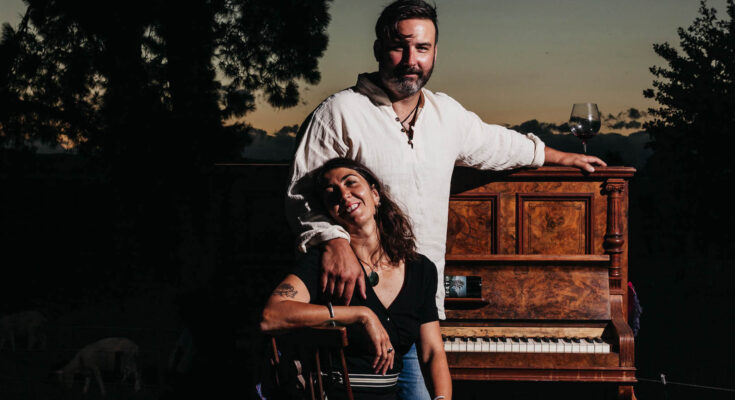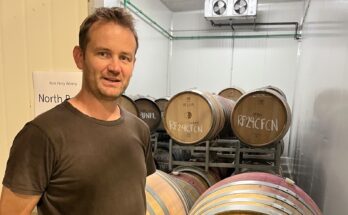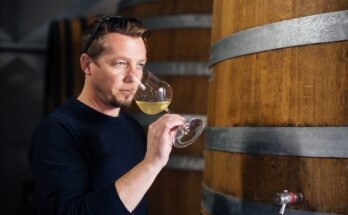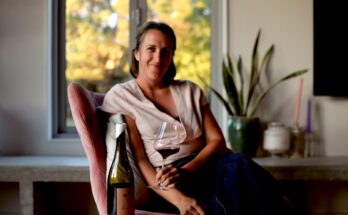Travelling around Hawke’s Bay, you get to realise that it’s a real community of wine people down here, with connections between families, companies and friendships. There’s a few names that keep cropping up as I talk to people – and today I’m off to Bridge Pa to meet one of those. I heard that Daniel Brennan moved to Hawke’s Bay from America, where it’s alleged he was in a well-known band, and started making some wines that have caught people’s attention. Not just for labels featuring imagery such as a lady riding a whale, but for the wines inside the bottle that are full of personality and flavour. I go in search of answers.
Daniel Brennan: You can sit right there, unfortunately we’re doing inventory today, so the big table has all the computers out and everything. This is the home of our growing team. We have an office upstairs as well – Rachel is up there, our Brand Manager. It’s our way of being able to live here and take over this property – we live here but we have the home office here as well. Storage in the back and we do private tastings here as well.
WineFolio: I’ve specialised in Tourism since I moved to New Zealand, but then I wanted to specialise a bit, and wine is what I’m really passionate about.
DB: Was that always sneaking in to your other stuff?
WF: Yes, I think so – I can look back a bit now and say yes it was! (laughs) I used to write a bit more about arts and culture, so this is someway going back to that. I liken it to music. Some people say wine is like art, and I disagree with that. Art can literally be anything, but music, like wine, has a structure – it delivers something to your senses – hearing or taste and it has a definite structure. But it’s also personal. You might prefer natural wine or jazz, and I may not, but it has a format that we can both start from. But more of a writer than a critic – telling stories more than giving opinions.
DB: You’ve come to the right place for stories about music and wine. First to qualify things – I’m a musician as much as if my buddy who gives me guitar lessons were to make wine in his garage and call himself a winemaker. People say to me “oh you used to be in a band” and I say, “No, I used to manage a band”. So I grew up playing guitar and playing in a couple of bands as kids. One of those guys I was in a band with got back to me when I was at Uni and said “Hey I got this thing going on”, and I threw a few big parties. By the time I graduated University, they asked me to manage them. So I Tour managed and Business managed them for about six years. They were from the Bronx New York and we toured all over North America.
They were already a pretty busy touring band but the likes of Napster and all that made it impossible to sell albums any more, for indie bands. That just meant we had to tour more. We were opened up to a whole new audience because of those applications. It changed the game in terms of being able to go into a venue and all of a sudden you don’t sell $1500 worth of CDs at a show. That dwindled very quickly. But all of a sudden people in Colorado and Canada had heard of them, so they got to go and be on some more bills and that. And different bands heard of us. They were a little bit older than me, so when they started to settle down a little bit and having kids, and admitted they had peaked – it just became an impossible way of life to keep touring.
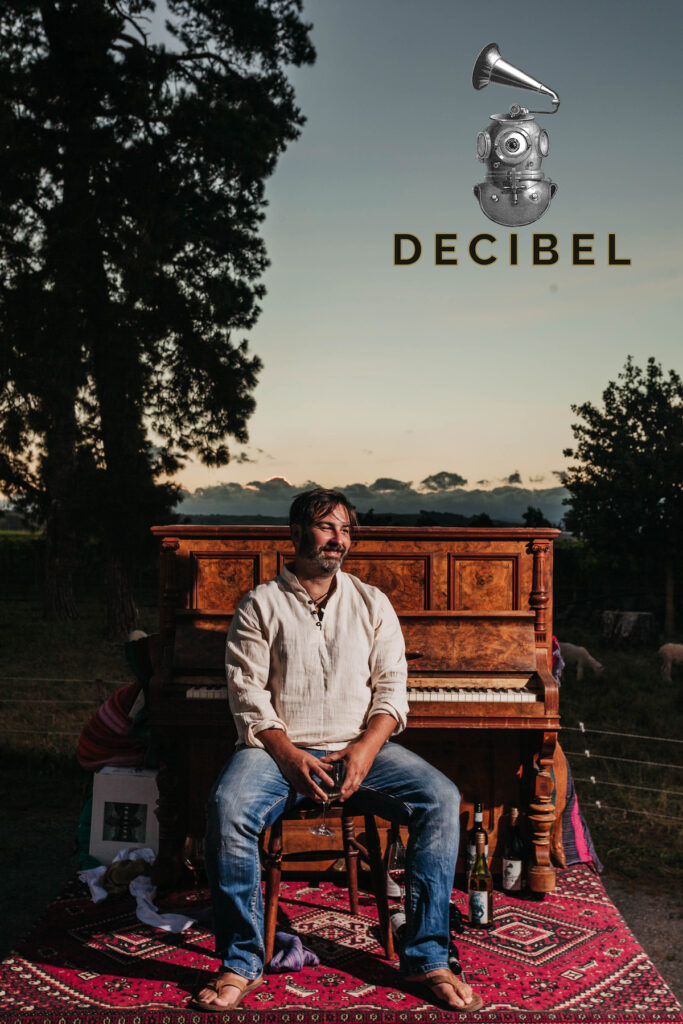
I settled back into my family’s restaurant which had been in the family since prohibition. And when I was a kid it was like a beer and shot bar. Ten in the morning it was packed kind of place – an ironworkers bar. In fact its nickname was ‘The Dustbowl’. That was when it was my Father’s uncles. But then my Mother and Father, and my Mother’s brother, which was the Sicilian side of the family – they bought it. And to this day it’s still a gorgeous place – it’s an Irish-English tavern-looking place. My brother runs it and it has really good cuisine with a Mediterranean twist. A lot of comfort food, kind of that gastropub thing, before it even existed in the early 90s.
We always had good wine around when I was a kid. As it turned out my Great Grandfather was actually a winemaker and a cooper; and I didn’t really know that until I moved here and decided to do wine.
And my grandfather made wine in the basement as most South Philly Sicilians do, but that was pretty much plonk. Then I got into wine and there was a WSET at the night school in Philadelphia I was going to, running monthly tastings. And I was blown away by Martinborough Pinot. I know I’m here in Hawke’s Bay but it was actually Martinborough Pinot that got me here. And I was just like “What is this stuff!?” And overall, New Zealand wine. I was immediately drawn in by Sauvignon Blanc, but then the likes of Palliser, Dry River, Ata Rangi, Escarpment, Martinborough vineyards. I couldn’t get them all either – I had to drive to other states to go to tastings and stuff. And so I went to the guy who owned this place – The Wine School of Philadelphia – and I knew he’d been overseas. I really had no idea at this point what “vintage” was. I said I want to do this – I want to get out of the restaurant. And he said, “You’d better start studying Chemistry” and said ‘oh shit’ (laughs). I hadn’t studied that since High School, although I did good in Math and Science, but my first degree was in Political Science and Philosophy. And I read all the time, but I liken it to someone who says “I jog everyday’ and you say ‘good – here’s a basketball’. It’s kind of a different muscle you know?
That’s exactly what it was like when I moved here but I did look at one other place, which was really far down the line as a second choice, which was Washington State. Because I was looking for up-and-coming cool climate. But I found the school at Hawke’s Bay so I went and did a three year degree here and hit the ground running. I never looked at Davis – it was too expensive – and I knew if I was going to be doing Chemistry and Microbiology that it had to be in English. There’s only a few of those special people like Hiro Kusuda who went to Germany and taught himself German. I’m not going to do that, it’s a big enough challenge anyway. I don’t remember ever tasting a Hawke’s Bay wine until I got here. So I kind of moved to Hawke’s Bay sight unseen.
WF: what do you think you’ve found in Hawke’s Bay that you couldn’t have found, or learnt, elsewhere?
DB: I think the range of varietals – we can ripen Cabernet every year, we do Pinot Noir and amazing aromatic whites. There’s no other region in New Zealand that can do that. Wines that really speak of a place like Syrah. Some really good entry-level Sauvignon Blanc, which is a really big part of my business now.
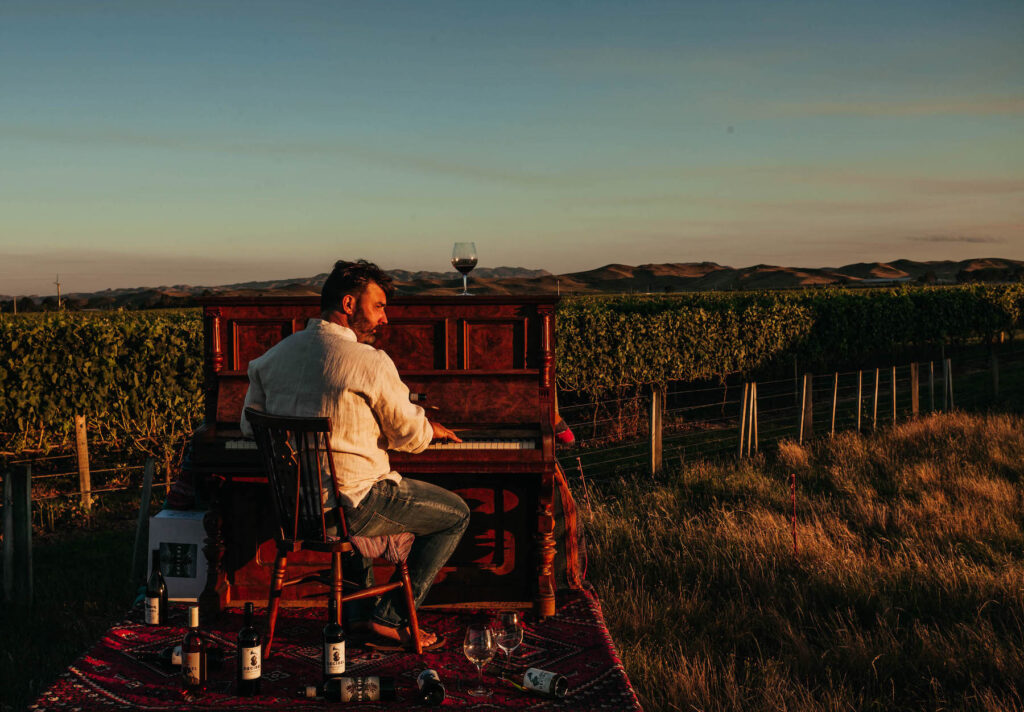
WF: I would agree with that, and I think the Chardonnay from here is really good – world class to some degree. And you’ve got people like Kumeu River, who make a superb Chardonnay, now making wine from Hawke’s bay vines too.
DB: I would argue though that Michael is such a force, that that’s probably more producer-driven than, than regional. They’re making some phenomenal stuff already from Hawke’s Bay. They’ve paved the way for New Zealand Chardonnay producers. I started making some of my own in 2018, and it took out top in Cuisine, and it’s doing really good and has added a lot of cache to our Testify range. But it’s pretty limited in what I export. I have that conversation quite a bit with friends who are winemakers here, and export customers too. That in the Grand World of Wine, which is a huge world, we’re a drop in the ocean. Te Mata Coleraine for example, which is a great wine – if you put that in a line up with other great wines of the world, like some great Italians and Bordeaux.. you’d probably get just as good a Barolo for $50 or $60. My big red wine is pretty far out there – Malbec dominant.
WF: I’ve had that quite recently, but I haven’t had the Testify range. And I believe that Ian Quinn gave me a bottle of Chenin Blanc but I haven’t got around to tasting it yet. I was waiting to do a tasting of all the Chenins off his vineyard as he tells me they’re quite different.
DB: They really are. It’s funny, and they’re not super heavy-handed winemaking either, they’re just subtle choices. Amy’s is skin-fermented so that’s got it’s own thing going on, but it’s not like super out there. 2020s will I think be really different because there’s more winemakers making it from there and pickings were further apart. And he’s transitioned the whole vineyard to organics, since last year. My Malbecs are all organic; the Pinot is from a vineyard that’s run organically and dry farmed. It’s happening quick in Hawke’s Bay and we can do it here – we have the climate to do it. If someone can do it in Gisborne, like James Millton, it’s really humid up there.
The Testify Chardonnay you mentioned – the ’18, that’s all gone. It’s not really a problem as we held it back, to wait for the range. So we didn’t push that wine at all. Then all of a sudden we got that Cuisine article and we did some events, and boom! Naturally people had tasted it and said ‘what the hell’s this stuff?’ It’s pretty smoky and flinty but I pulled back on that a little bit more on the ’19. But the ’19 has still got some interesting funk to it. It’s just a little more dialled-in for my taste. It’s looking really good. We knew that was coming for a few months – you know print media – they called us in July and it came out in October.
WF: I think you make an interesting range already, but is there anything else that you have an idea to try?
DB: I’d like to do more crunchy reds. I’d like to do something like Gamay or Franc. It just depends what fruit comes up. I really think that’s where the market’s heading as well. New Zealand’s a little bit behind the rest of the world. I started doing that Nouveau in ’17 and now a couple of years on a few of my mates are doing wines like that.. Young, fresh reds that are real approachable – crunchy and smashable. We can definitely do that in Hawke’s Bay too. I think there’s a little bit to be achieved in winemaking on that as well. Which varietals you choose and accept what level of green you like, and all that kind of stuff. Certainly Franc and Gamay fit into that. I really believe that Malbec does as well, but that is 13% every year – pick them a little earlier, fresher, brighter.
WF: Whole bunch as well?
DB: Some, but my little secret with that is that I do a little bit more maceration so it softens, and I do MLF, so it’s not too much, otherwise it would just be too much, because there’s a lot of acid in Malbec.
WF: Have you got plans for your own vineyard and place?
DB: Watch this space. We’re trying, yes. Some interesting stuff going on right now, so… The big player stuff is kind of it’s own thing, but there’s always vineyards for sale around. I would love more of a home base for everything right now. We’d love to be able to have a private Tasting Room. I probably wouldn’t do a big Cellar Door, but we’re looking right now at some places and we’ll see what happens.
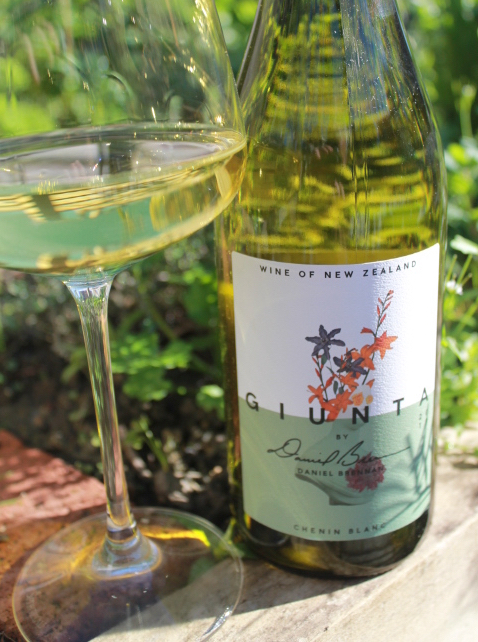
WF: I have to say, I’ve heard your name here and there – seems like appreciation is building, but also when I talk to people in the region as well.
DB: We’re all mates. Hayden, Amy, Olly and Amy are all friends – kids go to the same schools.
We start to try a few wines – I ask if we can start on Sauvignon Blanc
DB: Crownthorpe. I’ve been working with this vineyard since 2011, which is the longest time I’ve worked with one. No oak but lots of lees-stirring. That decision was mostly made because of price point. I kind of worked backward. It needs to be poured by the glass in my family restaurant, so start at that point and where does it get us? But most Sauvignon ought to be able to made at that price point.
Most of this goes to the US, and I think they care less about it being strictly Marlborough, and more about it being from New Zealand. At the som level, they kind of have to have a New Zealand Sauvignon Blanc, but they’re excited because they can a be a little bit geeky about it. We get a lot of doors opened because of this wine.
WF: I really like this, it’s one of the best I’ve had in a while. And I like to keep the ones that I discover I really like.
DB: That’s the big secret. Hawke’s Bay Sauvignon – third or fourth year in is where it’s at. Canada is currently on our 2017 and we just did a Zoom Tasting with our importers there and they were loving it. In fact, you wouldn’t want to be drinking the 2020s now until maybe at least way through next year. The 19s are just hitting their stride now. The two vineyards for Sauvignon Blanc – as far as the main part of Hawke’s Bay goes – couldn’t be further apart. So Crownthorpe and Te Awanga.
And this is Viognier – the first year I did it was ‘16 and I asked him to stop weed-spraying and start converting. Now the vines are finding their balance, cropping a little lower. What happened was in ’14 I was making a white wine and got a late call ‘heard you’re after some Viognier’, and I picked up juice basically straight from the press, and the result was a 14.5% Viognier. I can’t do that again. Too phynolic, too alcoholic. Then I found a site that I liked – it does need heat, and Bridge Pa Triangle is good for that. I didn’t want to dumb it down in any way. I want it to be a varietal wine but still pick a little earlier and let it sit on skins for 8-10 hours before you press. Try and get as much of those oily bits out, you know? But I’m going a bit more for that elegant style of Viognier. Less apricots.
WF: Got a nice lift to that though, and not as fat as many I try. It’s got something similar to – like a family resemblance to your Sauvignon Blanc even. In style and structure, more than flavour. I like that pithy, slightly tannic finish to it.
Speaking of the family – the labels! Not your average. What’s going on there? I remember the first time I saw them at a tasting at First Glass, which is my local wine shop, and Andrew introduced your wine – “Kingsley was out of the shop for a couple of hours last week, so I took the opportunity to buy some of this wine, and I’ve hidden it from him. Now – does everyone like this wine? That’s good, because wait until you see the label!”
DB: Yes, I was up in that shop and they said they weren’t sure about the labels – but then there was a Cuisine article and after that they said they’d give it a try. It ties in the story with the music thing, with decibel, travel -the juxtaposition with the people, landscapes.
WF: tell me what’s the difference between these two – they both have Martinborough Pinot Noir on them, but they look quite different, on the label, to the consumer?
DB: Same vineyard, this is all focussed on 667, 777 clones, and bit more new oak in that. The Decibel is the classic Martinborough style that I’ve made every year, and the Testify is only in certain years, if I think it’s up to scratch. But also going for a lot more purity of fruit, elegance on that one. The Decibel is going to deliver with some grunt. Sometimes people make their Reserve and they go “it’s bigger, bolder” but with the Testify, it’s more elegant. They are both ‘18s as it is now, but once we get into 2021, the Decibel will pull ahead we’ll sell through it quicker and we’ll be on the ’18 for Testify for quite a while. So that will pick up bottle age.
But we’ve done pretty good in previous years as far as holding back vintages and it’s a bit of push and pull. We don’t want to run out of Pinot, but that’s been really tricky because I also don’t release it until it’s been in bottle for about 15 months. So I tend to bottle after about ten months in oak as I like Pinots to have a freshness and a drive to them. I don’t see a lot of benefit in ageing Pinot in barrel for 18-20 months or something like that. But I do see huge benefit to not releasing them for about 15 months! They’re donuts for ages, and by that I mean it’s hollow in the middle. You might taste one after 6 months to confirm your suspicions. You get a hint of the aromatics and there’s nothing wrong with it, but then when you taste it, it’s just got no flow. That was really scary the first couple of years I made Pinot. I though ‘what the heck happened to my wine – that’s not my wine” But then it slowly creeps back and usually by August/September the following year it’s in a really good position.
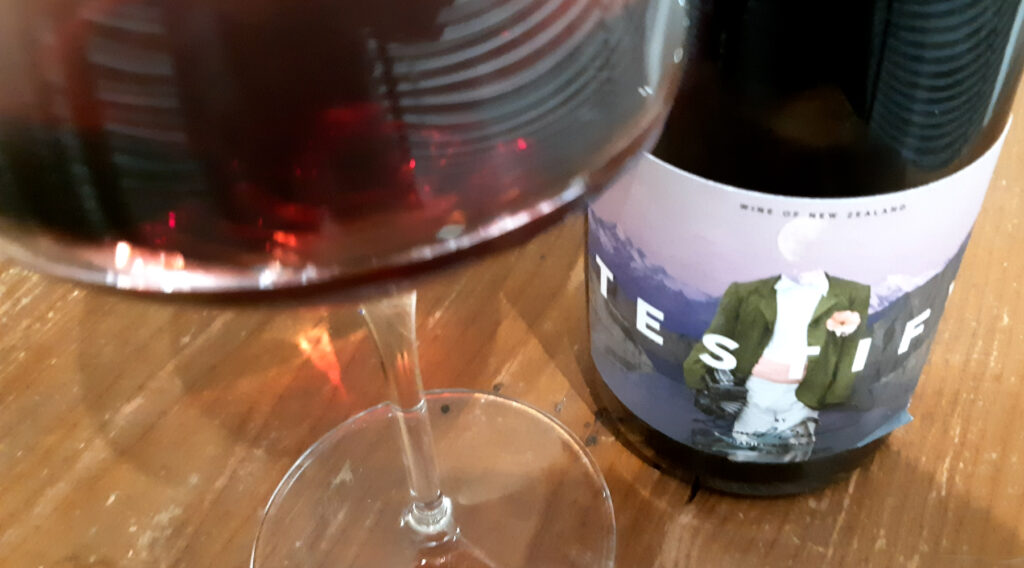
And you can almost see the light that the one year in bottle does. But this one, about 6 months ago, had this orange rind thing going on, but that’s really developed now and it’s gone a little bit more caramelised. You’re getting more of the savoury and forest floor and all that kind of stuff. I love the way this wine has changed over the year.
WF: It’s quite exotic as well. Slightly musky and umami thing happening. I like what you said about the orange rind, because I’m getting blood orange in this – almost a Seville orange marmalade note underneath.
So it’s Martinborough – whereabouts?
DB: Dublin Street, it’s off on its own. I’ve been working with the vineyard since 2016. In ’16 the old man there, James Brodie had his own label and I just stepped in the first year and I said “let’s just do what you normally do, use the usual cooperages and I’ll just learn, and we’ll make a wine.” And it was good, and we did that.
And I said “next year we’ll do what I think we should do”. In ’16 we made two wines, and I was going to buy up all the fruit from ’17. Except in ’17 we picked everything in one day. It’s a 3 hectare vineyard so my plan went to shit because we basically picked between two cyclones. I’m really proud of that ’17, we got some great reviews and everything, but the ’18 was the first year I actually did what I wanted. Picked across three and a half weeks. A lot more cap management than he’d ever done and really separated by clones. I’d done years of research on cooperages I really liked – and I’m still doing that! But ’18 is the first year it came in line as far as having a plan and being able to stick to it.
WF: That’s a great wine – a Martinborough classic style. I like the price of it too. There’s so many $40 Pinots that it’s so crowded.
DB: The Testify, I thought was ahead of this one for a while, now its slowed down in development and I can see why now, because some of those oak choices are only just starting to flourish.
WF: OK, that’s odd. On the nose I think you could have passed them off as the same wine. Ish – a bit different. But massively different on the palate. So cultured, but quite powerful and tense.
DB: About 3 months ago I thought “did I just make a silky, smashable wine?” To me those two Dijon clones – 777 and 667, all on the clay soils, dry farmed. There’s this tension going on, and the perk of those clones, with the fatness of the soils. We’re going to take our time getting them out. I only have four barrels of the ’19, but I got some fruit from Nga Waka and I’m going to make a different Decibel Pinot as well. Possibly just as an export wine. I love the challenge of working with people – those people with just a small block, and I’m like “come with me..”

